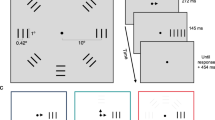Abstract.
The detection of compound sinusoidal gratings of various spatial frequency separations and four different grating sizes has been studied using the summation-to-threshold paradigm. Contrast interrelation functions have been measured and spatial frequency tuning estimates, based on the slope of the contrast interrelation function at two definite points, were derived using the “negative gradient technique” proposed by Logvinenko [Logvinenko (1995) Biol Cybern 73: 547–552]. It is shown that compound grating detection can be modelled by assuming pattern-specific sensory mechanisms for each of the spatial frequency components, which adapt to the periodicity and the size of the stimulus but not to its envelope function. Further, it is shown that relative sensitivity for a given spatial frequency separation can be predicted with good accuracy by the correlation of the grating components used for superposition. It is suggested that the most plausible implementation of the pattern correlation principle in human grating detection is the “grating cell” model.
Similar content being viewed by others
Author information
Authors and Affiliations
Additional information
Received: 10 March 2000 / Accepted in revised form: 4 December 2000
Rights and permissions
About this article
Cite this article
Meinhardt, G. Detection of sinusoidal gratings by pattern-specific detectors: further evidence for the correlation principle in human vision. Biol Cybern 85, 401–422 (2001). https://doi.org/10.1007/s004220000236
Issue Date:
DOI: https://doi.org/10.1007/s004220000236




